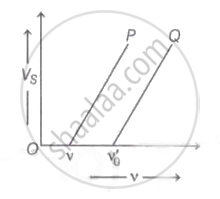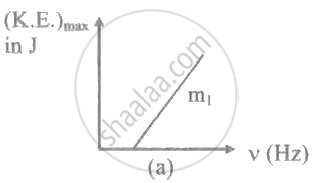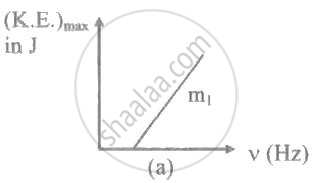Advertisements
Advertisements
प्रश्न
Given the following data for incident wavelength and the stopping potential obtained from an experiment on the photoelectric effect, estimate the value of Planck's constant and the work function of the cathode material. What is the threshold frequency and corresponding wavelength? What is the most likely metal used for emitter?
| Incident wavelength (in Å) | 2536 | 3650 |
| Stopping potential (in V) |
1.95 | 0.5 |
उत्तर
Data: λ = 2536 Å = 2.536 × 10-7 m,
λ' = 3650 Å = 3.650 × 10-7 m,
V0 = 1.95 V, V0' = 0.5 V, c = 3 × 108 m/s,
e = 1.6 × 10-19 C
(i) `"V"_0"e" = "hc"/lambda - phi and "V"_0'"e" = "hc"/(lambda') - phi`
∴ `("V"_0 - "V"_0')"e" = "hc" (1/lambda - 1/(lambda '))`
∴ (1.95 - 0.5)(1.6 × 10-19)
= h (3 × 108)`(10^7/2.536 - 10^7/3.650)`
∴ 2.32 × 10-19 = h(3 × 1015)(0.3943 - 0.2740)
∴ h = `(2.32 xx 10^(-34))/0.3609 = 6.428 xx 10^(-34)` J.s
This is the value of Planck's constant.
(ii) `phi = "hc"/lambda - "V"_0"e"`
`= ((6.428 xx 10^-34)(3 xx 10^8))/(2.536 xx 10^-7) - (1.95)(1.6 xx 10^-19)`
`= 7.604 xx 10^-19 - 3.12 xx 10^-19 = 4.484 xx 10^-19`J
`= (4.484 xx 10^-19"J")/(1.6 xx 10^-19 "J"//"eV")`
= 2.803 eV
This the work function of the cathode material.
(iii) Φ = hv0
∴ The threshold frequency, `"v"_0 = phi/"h"`
`= (4.484 xx 10^-19 "J")/(6.428 xx 10^-34 "J.s") = 6.976 xx 10^14` Hz
(iv) `"v"_0 = "c"/lambda_0`
∴ The threshold wavelength, `lambda_0 = "c"/"v"_0`
`= (3 xx 10^8)/(6.976 xx 10^14) = 4.300 xx 10^-7` = 4300 Å
(v) The most likely metal used for emitter: calcium.
APPEARS IN
संबंधित प्रश्न
If the frequency of incident light falling on a photosensitive material is doubled, then the kinetic energy of the emitted photoelectron will be ______.
What is the photoelectric effect?
Radiation of wavelength 4500 Å is incident on a metal having work function 2.0 eV. Due to the presence of a magnetic field B, the most energetic photoelectrons emitted in a direction perpendicular to the field move along a circular path of radius 20 cm. What is the value of the magnetic field B?
With the help of a circuit diagram describing an experiment to study the photoelectric effect.
The ratio of energies of photons produced due to transition of electron of hydrogen atom from its (i) second to first energy level and (ii) highest energy level to second level is respectively.
Which one of the following is TRUE in photoelectric emission?
When a photon enters glass from air, which one of the following quantity does not change?
The graph of stopping potential `"V"_"s"` against frequency v of incident radiation is plotted for two different metals P and Q as shown in the graph. ΦP and ΦQ are work-functions of P and Q respectively, then

When light falls on a metal surface, the maximum kinetic energy of the emitted photoelectrons depends upon ______
In photoelectric experiment, if both the intensity and frequency of the incident light are doubled, then the saturation of photoelectric current ______.
In photoelectric effect, for a light of different intensities but of same frequency, the stopping potential for a given metal is ____________.
When light of wavelength 'λ' is incident on a photosensitive surface, the stopping potential is 'V'. When light of wavelength '3λ' is incident on the same surface, the stopping potential is `"V"/6`. Threshold wavelength for the surface is _______.
The photo electric effect to take place for a metal, the minimum frequency required is 5.792 × 1014 Hz. A light of wavelength 6000 Å is incident on that metal surface. What is the corresponding frequency of light and will there be photoelectric emissions? [velocity of light = 3 × 108 m/s]
Photoelectrons are emitted from a photosensitive surface for the light of wavelengths λ1 = 360 nm and λ2 = 600 nm. What is the ratio of work functions for lights of wavelength 'λ1' to 'λ2'?
The work function of a substance is 4.0 eV. The longest wavelength of light that can cause photo-emission from this substance is approximately (h = 6.63 × 10-34 Js)[1eV = 1.6 × 10-19 J]
Following graphs show the variation of stopping potential corresponding to the frequency of incident radiation (F) for a given metal. The correct variation is shown in graph (v0 = Threshold frequency).
An electromagnetic wave of wavelength '`lambda`' is incident on a photosensitive surface of negligible work function. If the photoelectrons emitted from this surface have the de-Broglie wavelength '`lambda_1`' then ____________.
A metal surface having work function 'w0' emits photoelectrons when photons of energy 'E' are incident on it. The electron enters the uniform magnetic field (B) in perpendicular direction and moves in circular path of radius 'r'. Then 'r' is equal to (m and e be the mass and charge of electron respectively) ____________.
The ratio of slopes m1: ro2 of the lines given in the following graphs is, ______.


A light of frequency 'v' is incident on the metal surface whose threshold frequency is 'v0'. If v = v0, then [c = speed of light in medium] ____________.
A point isotropic light source of power P = 12 watts is located on the axis of a circular mirror of radius R = 3 cm. If the distance of the source from the centre of the mirror is a = 39 cm and the reflection coefficient of the mirror is α = 0.70 then the force exerted by the light ray on the mirror is ______ × 10-10 N.
On a photosensitive material when frequency of incident radiation is increased by 30%, kinetic energy of emitted photoelectrons increases from 0.4 eV. The work function of the surface is ______.
Light of wavelength λ, which is less than threshold wavelength is incident on a photosensitive material. If incident wavelength is decreased so that emitted photoelectrons are moving with same velocity, then stopping potential will ______.
Light of two different frequencies whose photons have energies 1.3 eV and 2.8 eV respectively, successfully illuminate a metallic surface whose work function is 0.8 eV. The ratio of maximum speeds of emitted electrons will be ______.
If the maximum kinetic energy of emitted electrons in the photoelectric effect is 2eV, the stopping potential will be ______.
The threshold frequency for a certain metal for photoelectric effect is 1.7 x 1015 Hz. When a light of frequency 2.2 x 1015 Hz is incident on the metal surface, the kinetic energy of the emitted photoelectrons is 3.3 x.10-19 J. Calculate Planck's constant.
In a photoelectric experiment, the stopping potential is 1.5V. What is the maximum kinetic energy of a photoelectron?
